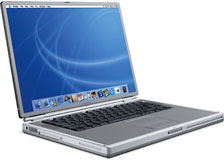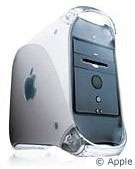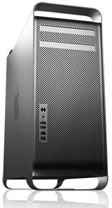Mac Musings
Too Much Focus Means Too Few Mac Expansion Options
Daniel Knight - 2011.02.16 -
Follow Low End Mac's blogs: LEMblog and Low End Mac Services.
This week marks the fifth anniversary of the first 15" MacBook Pro shipments (see MacBook Pro: Five Years of Goodness) - and the 11th anniversary of the introduction the last of the expandable Mac notebook, the Pismo PowerBook.

WallStreet PowerBook G3
And as much as we love the Pismo here at Low End Mac, the WallStreet PowerBook was even more expandable. And, of course, bigger and heavier.
The WallStreet, Lombard, and Pismo G3 PowerBooks had a lot in common: G3 processors, 14.1" 1024 x 768 displays (WallStreet had some other options), a 12.7" by 10.4" footprint, two device bays for batteries and drives, and PC Card expansion. Lombard and Pismo were 1.7" thick, weighed just over 6 lb., and had one PC Card slot, while WallStreet was 2.0" thick, weighed over 7 lb., and had two PC Card slots.
These were transitional machines: WallStreet has ADB, Apple serial, and SCSI ports. Lombard replaced ADB and serial ports with USB. And Pismo replaced SCSI with FireWire, making it the first PowerBook with both USB and FireWire - ports that remain on Apple's pro 'Books to this day, albeit in updated form.

Titanium PowerBook G4
Since Pismo was replaced by the 1" thin 15" Titanium PowerBook G4 in January 2001, it's been a downhill slide in terms of expansion options. Since Pismo, there have been no device bays, no way to add a second battery, no simple way to swap out the optical drive.
The 15" and 17" PowerBooks retained the lone PC Card slot found in Lombard and Pismo, but that gave way to an ExpressCard/34 slot when Apple introduced the 15" MacBook Pro. It also appeared on the 17" MacBook Pro, where it remains to this day, but in 2009, Apple dropped the ExpressCard slot from the 15" MacBook Pro, replacing it with the far less flexible SD Card slot. The Mid 2009 model also dispensed with the removable battery.
From a peak number of expansion options in the 1998 WallStreet, Apple has removed expansion options one by one - no more drive bays, no more user replaceable batteries, no more PC Card or ExpressCard slots except on the top-end 17" MacBook Pro.
Granted, the newer 'Books have also been more powerful, accepted more memory, used higher capacity and often faster hard drives (and now SSD), and greatly improved graphics, but the expansion options that WallStreet, Lombard, and Pismo owners loved are long gone from Apple's MacBook Pro line.
The Other Pro Macs

Sawtooth Power Mac G4
Apple's pro desktop line has gone just the opposite way. Early Power Macs had three NuBus slots, the Beige G3 had three PCI slots, and the Blue & White G3 had four - three 64-bit 33 MHz slots and one 32-bit 66 MHz slot used by the video card. It also added a second optical drive bay. The Sawtooth Power Mac G4 retained the three 64-bit slots and moved to AGP for video. The Digital Audio Power Mac G4 improved that by adding a fourth PCI slot. (There were even some Macs and clones with six PCI slots prior to the G3!)
With the Power Mac G5, Apple introduced a whole new enclosure with a lot more internal drive bays. While adopting SATA to replace parallel ATA, Apple also reduced the number of optical drive bays to one and the number of expansion slots by one. The Power Mac G5 had three PCI or PCI-X slots, in addition to AGP for video.

Mac Pro
The last generation Power Mac G5 moved to a new expansion bus, PCI Express, which has also been used in the Mac Pro. The Mac Pro brought back the second optical drive bay and has had more build-to-order options than you can shake a stick at - everything from two dual-core CPUs to two six-core processors, a variety of video card options, a host of memory configurations, and so forth.
Today's Mac Pro is the most powerful computer Apple has ever sold and also one of the most expandable.
Back to 'Books
But what of the MacBook Pro? While the Windows world has had quad-core laptops for some time, that's not even an option on the MacBook Pro. And while expandability is a key concept behind the deskbound Mac Pro, it's barely an option for the "pro" MacBooks.
Are MacBook Pro users considered second class at Apple? Why can't they have quad-core processors, drive bays, and, unless they choose the 17" model, expansions slots?
Conversely, we have the iMac and Mac mini, both desktops bereft of expansion slots and drive bays.
Too Few Macs
Apple has a great business model, allowing it to sell a limited number of models at premium prices, grow its market share, and remain incredibly profitable. Apple has focus. Unlike Dell and HP, it doesn't offer myriad desktop, notebook, and netbook models.
Apple puts the focus on the product, not on profits or market share. The focus is on the user experience - nice look and feel, an interface that gets out of the way, products with smooth edges, quality build, things that just work, and great customer support.
Most of all, Apple doesn't sell itself short. It makes unique products, sets trends for multiple industries, and sells a non-commodity product at a non-commodity price.
However, it's possible that Apple has too much focus. I don't want to see Apple go back to the bad old days of competing consumer, education, and business brands for exactly the same machine, and I'm glad it has moved beyond the "four box" model matrix (consumer and pro desktop and notebook Macs) of the late 1990s.
Apple addressed consumer demand for a Mac netbook by designing a real Mac in a netbook-sized case. The MacBook Air uses a full-fledged dual-core Intel Core processor, not an underpowered Intel Atom CPU, and it costs a lot more than the $260 to $375 netbooks that dominate the market.
Apple addressed demand for a small desktop with the Mac mini, which was nearly perfect when it was introduced in 2005 with a G4 CPU. It's the perfect Mac to connect to your flat panel TV or your old PC monitor.
The polycarbonate MacBook is nearly perfect as a consumer notebook, and the iMac meets most users' needs for a desktop computer.
Two More Niches
But there are two holes in Apple's product line. It should offer at least one pro notebook with a removable battery and an expansion bay for those who travel a lot. This would not be a huge seller, but there is a market for it.
Likewise, there is a market for a midrange modular Mac, something more expandable and perhaps more powerful than the Mac mini but less expandable and perhaps less powerful than the Mac Pro. Give us at least one more drive bay and at least one expansion slot so we can add an internal backup drive and that USB 3.0 port that Apple still doesn't provide. Give us a chance to upgrade to new technologies without buying a top-end Mac Pro or replacing the whole iMac or Mac mini.
I'm not asking Apple to fill every possible niche, which is the Walmart, General Motors, Dell, and Nokia strategy, to name only a few companies the subscribe to portfolio theory. Keep the focus, but focus on those few niches that are important. Power users with notebooks. Home and office users who need a little more expandability. People who want something bigger than an iPhone but smaller than an iPad.
Focus. Do it right. And the profits will continue to grow.
Join us on Facebook, follow us on Twitter or Google+, or subscribe to our RSS news feed
Dan Knight has been using Macs since 1986, sold Macs for several years, supported them for many more years, and has been publishing Low End Mac since April 1997. If you find Dan's articles helpful, please consider making a donation to his tip jar.
Links for the Day
- Mac of the Day: 15" 'TiBook' PowerBook G4, (2001.01.09. A new 1" thin PowerBook design with a titanium case and 15" widescreen display.)
- Support Low End Mac